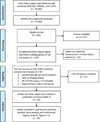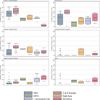Worldwide risk factors for heart failure: a systematic review and pooled analysis
- PMID: 23201083
- PMCID: PMC3594565
- DOI: 10.1016/j.ijcard.2012.11.065
Worldwide risk factors for heart failure: a systematic review and pooled analysis
Abstract
Background: Heart failure risk factors are diverse and likely to vary among world regions. Systematic review and pooled analysis were used to describe contributions of major underlying risk factors for heart failure in six world regions.
Methods: Electronic databases were systematically searched, and 37 clinic-based studies representing 40 countries published in 1980-2008 and reporting underlying risk factors for heart failure were included. Risk factors were classified as ischemic heart disease (IHD), hypertension, rheumatic/other valvular heart disease, cardiopulmonary disease, cardiomyopathy, and "other". Crude and age- and sex-adjusted risk factor prevalences were estimated for each region using a regression analysis, under specifications of overlapping as well as additive contributions.
Results: Many heart failure cases were assigned multiple underlying risk factors, leading to a considerable overlap. Crude IHD prevalence among heart failure patients was >50% in Europe and North America, approximately 30-40% in East Asia and Latin America and the Caribbean, and <10% in Sub-Saharan Africa. Age and sex adjustment attenuated regional differences in IHD-as-risk factor but IHD remained rare in Sub-Saharan Africa. Hypertension prevalence was high in heart failure patients of all regions but the highest in Eastern and Central Europe and Sub-Saharan Africa (age- and sex-adjusted, 35.0% and 32.6%, respectively). Cardiomyopathy was most common in Latin America, the Caribbean and Sub-Saharan Africa (age- and sex-adjusted, 19.8% and 25.7%).
Conclusions: Heart failure risk factors vary substantially among world regions. More detailed regional heart failure epidemiology studies are needed in order to quantify the global burden of heart failure and identify regional prevention and treatment strategies.
Keywords: Epidemiology; Global health; Heart failure; Risk factors.
Copyright © 2012 Elsevier Ireland Ltd. All rights reserved.
Conflict of interest statement
Figures





References
-
- McMurray JJ, Petrie MC, Murdoch DR, et al. Clinical epidemiology of heart failure: public and private health burden. Eur Heart J. 1998;19(Suppl P):P9–P16. - PubMed
-
- Gheorghiade M, Bonow RO. Chronic heart failure in the United States: a manifestation of coronary artery disease. Circulation. 1998;97:282–289. - PubMed
-
- Massie BM, Shah NB. Evolving trends in the epidemiologic factors of heart failure: rationale for preventive strategies and comprehensive disease management. Am Heart J. 1997;133:703–712. - PubMed
-
- Killip T. Epidemiology of congestive heart failure. The American journal of cardiology. 1985;56:2A–6A. - PubMed
-
- Mendez GF, Cowie MR. The epidemiological features of heart failure in developing countries: a review of the literature. International journal of cardiology. 2001;80:213–219. - PubMed
Publication types
MeSH terms
Grants and funding
LinkOut - more resources
Full Text Sources
Other Literature Sources
Medical

